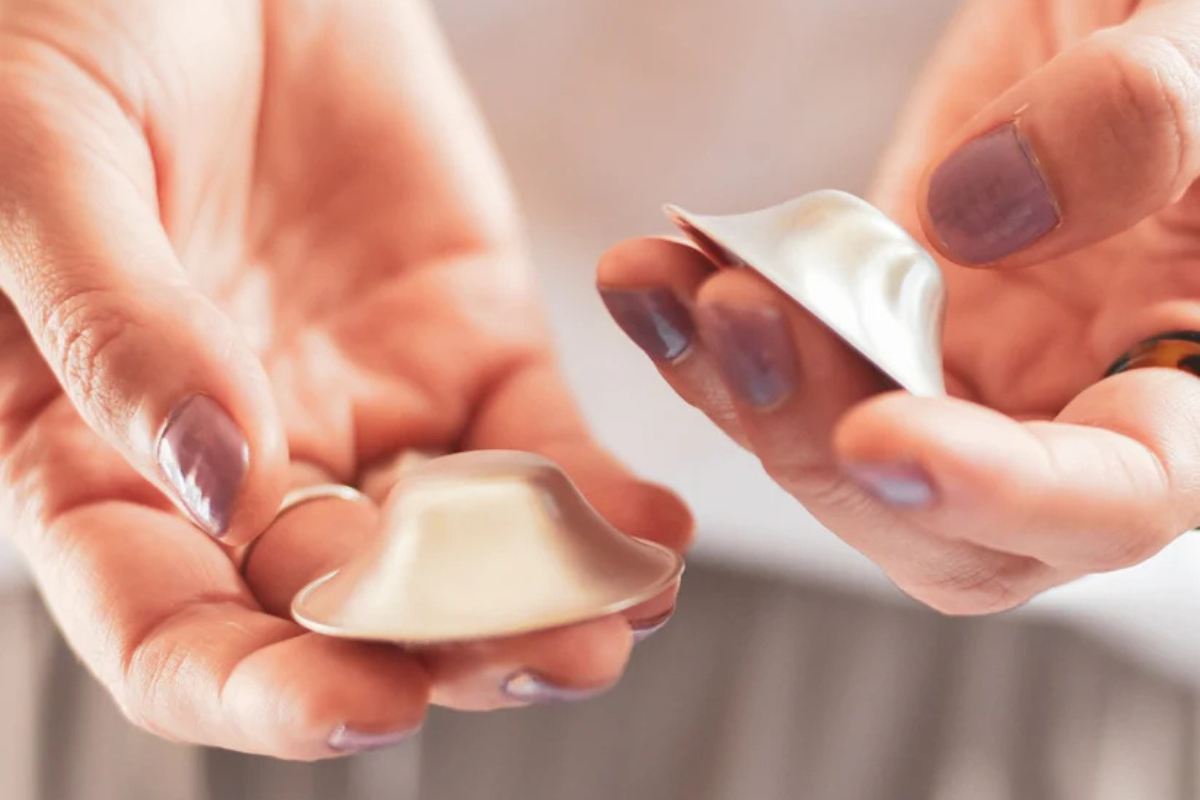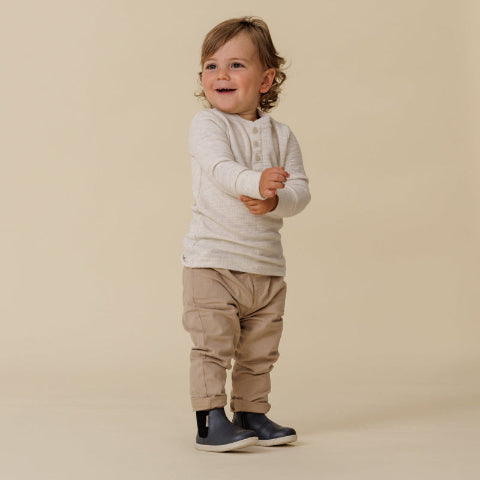Here’s how we create a peaceful and practical bath time routine with a few of our favourite bathtime products at Whisper & Wild
What benefits are made choosing organic cotton children's clothing?
We all know that babies and children can quickly grow out of their clothing. So what is the environmental impact of this and what can we do about it?
The environmental harm of children’s fashion can come from a variety of sources including the use of harmful chemicals in textile production, the transportation and distribution of clothing, and the disposal of clothing that is no longer worn. In addition, fast fashion practices, which is the constant release of mass produced, low quality clothing at a very low price can contribute significantly to environmental harm by generating large amounts of textile waste, not to mention the poor labour conditions that such low pricing creates. Here are some of the ways the children’s fashion industry can harm the environment:
- Fast fashion: Many children’s fashion companies engage in fast fashion, which involves producing clothing quickly and cheaply to keep up with changing trends. These include big supermarket types such as Kmart, Target and high street brands such as H&M. This often results in poor working conditions for factory workers and a high environmental impact due to the use of synthetic materials and chemicals.
- Textile waste: Children grow quickly, and as a result, their clothing often gets worn out or outgrown before it can be worn for long. This results in a large amount of textile waste that can harm the environment.
- Chemical pollution: Many children’s clothing items are made from synthetic materials that are treated with chemicals to make them wrinkle-free, fire-resistant, or water-repellent. These chemicals can harm the environment when they are released into the air or water during production and disposal. The use of synthetic fibers, such as polyester, in children’s clothing also contributes to environmental harm, as they are not biodegradable and can release microplastics into the environment.
- Packaging waste: Children’s clothing is often sold in plastic packaging, which can contribute to plastic pollution when it is not properly disposed of.
- Transportation: The production, transportation, and disposal of children’s clothing all contribute to a large carbon footprint. The transportation and distribution of clothing contributes to greenhouse gas emissions.
It is important to consider sustainable practices and make conscious choices when purchasing children’s clothing. Here are some ways children’s clothing brands are creating clothing in a less harmful way:
- Using organic and natural materials. Using organic fabrics means there are no pesticides, chemicals and herbicides used during the growing process and therefore less toxic waste being sprayed into the environment. These practices are not only ethical, but strive for sustainability long term
- Manufacturing in smaller quantities. Brands can manufacture in smaller quantities and reduce the textile waste that will end up in landfill. This is more expensive to do as big mass brands want to manufacture in bulk for cheaper pricing and more cost efficient transportation. Support smaller brands that manufacture in smaller runs and pay their workers a living wage.
- Creating higher quality clothing that can be passed on. Paying a higher price to begin with can mean more savings in the future. Instead of purchasing from cheaper, bigger brands, purchase less from a higher quality children’s brand which can mean a longer wear life.
-
Ensuring fair pay & great working environments for the production of the garments.
The clothing industry employs millions of people, often in developing countries. Labour regulations can be at a much lower standard than in the Western world, and fast fashion has a lot to answer for. Buying eco-friendly reduces the exposure of these workers to toxic compounds. This in turn avoids a health hazard to them and their families. About 77 million agricultural workers suffer poisoning from pesticides each year growing conventional cotton. Additionally, exposure to azo dyes correlates with cancer in textile workers.
Organic Materials Vs Synthetic
Synthetic fabrics, such as nylon, polyester, and acrylic, can take anywhere between 20 to 200 years to decompose. You’re probably already aware of the increasing textile waste problem we’re currently facing. Landfills are filled to overflowing, we need to make conscious choices as consumers to reduce this!
Natural fibres like certified organic cotton, hemp & more tend to avoid this problem. When your kids’ clothing has reached the end of its useful life, it’s reassuring to know that it will break down naturally, or biodegrade.
So what sustainable textiles should you consider when purchasing for your children's wardrobes?
- Linen: Made from flax, which requires far less water, fertilizer, and pesticides than cotton. It requires little energy to manufacture and is easy to compost or recycle into paper.
- Hemp: Doesn’t need much fertiliser or pesticides. Transformable into a wide variety of organic fabrics, including canvas, denim, jersey, fleece, and twill.
- Bamboo: Has both pros and cons as a sustainable fiber. It grows fast and requires almost no pesticides. The fabric it produces is soft and easy to care for. However, turning the fibres into cloth often requires toxic chemicals.
- Lyocell: A fabric made from wood pulp, typically the eucalyptus tree, which grows quickly with little water or chemicals. The material produced is naturally wrinkle-resistant, so it’s easy to care for.
- Alpaca: Alpacas are similar to llamas and are native to Peru. They have long hair that produces beautifully soft fibres. Alpacas are hardy animals and don’t eat or drink much. They can also stay healthy without antibiotics. Alpaca wool is more eco-conscious than cashmere.
- Organic wool: Organic sheep farms don’t use traditional toxic pesticides on their pastures or treat their animals with toxic dips. Organic farmers keep their sheep and pastures healthy utilizing the animal’s manure to nourish the soil.
- Silk: Produced by caterpillars known as silkworms. This natural fabric is lightweight and durable. At the end of its life, it breaks down naturally.
There’s a lot of confusing blurb used when it comes to sustainable clothing, but there is a secure way to evaluate a brand’s green credentials. Certifications are crucial because they reveal a lot of information about how a garment was made and what the working conditions are like.

The Global Organic Textile Standard GOTS covers the processing, manufacturing, packaging, labelling, trading, and distribution of all textiles made using at least 70% certified organic fibers. GOTS certification also includes an Örganic” grade which means it must contain a minimum of 95% certified organic fibers.
While GOTS certified organic cotton is definitely something to look out for, this standard focuses not just on cotton, but all organic fibers, including wool, bamboo, and silk.
Furthermore, this standard sets limits on the environmental impacts of the production process. These limits include restricting toxic and potentially toxic chemicals, no use of azo dyes that release carcinogens, biodegradability requirements, waste management, and water treatment and packaging materials.
Workers should be able to choose their employment. There must be no child labour. Finally, health and safety criteria are met, and fair wages paid.

The Oeko-Tex Standard is a four-tier system used to evaluate the toxicity of chemicals present in clothes. Compliance tests are run by independent inspectors. Oeko-Tex certification is often awarded in conjunction with GOTS certification.
So yes, often organic children's clothing comes at a higher price point but when you consider all that you are actually paying for it makes investing in quality organic items as consumers beneficial beyond the item itself. Consider reusing the garment by handing over to other family and friends or dropping of to a secondhand store to be worn over. Usually, quality organic textiles will still be in great condition for this.
Some of our favorite organic clothing brands are...
1. Huxbaby - Sustainability (huxbaby.com)
2. Grown Clothing - Our Mission – Grown Shop
3. Quincy Mae - ORGANIC + ETHICALLY MADE - Quincy Mae NZ & AU
4. Boody - About Boody Eco Wear | Bamboo Clothing | Boody New Zealand
5. Veja - Transparency | VEJA (veja-store.com)
6. Buck & Baa - We Love Mother Earth - Our Sustainability Mission – Buck and Baa




0 comments